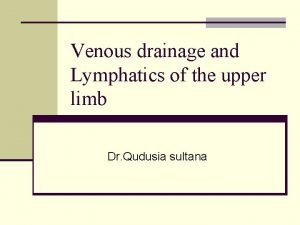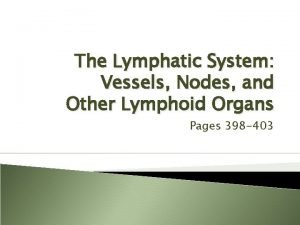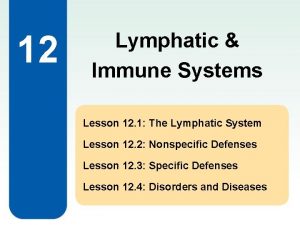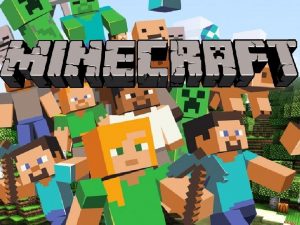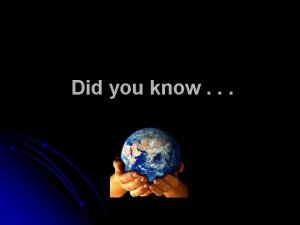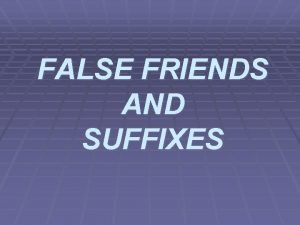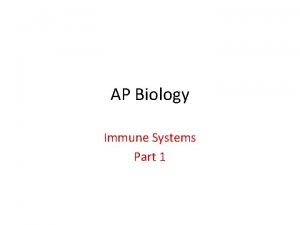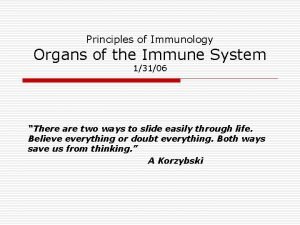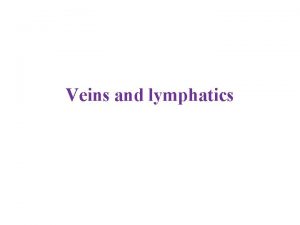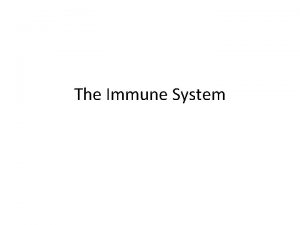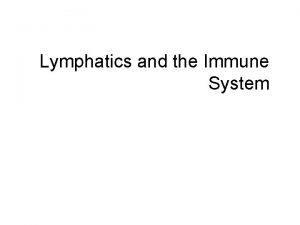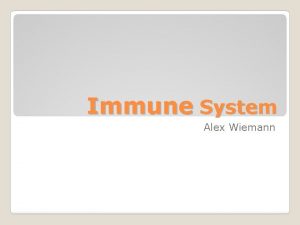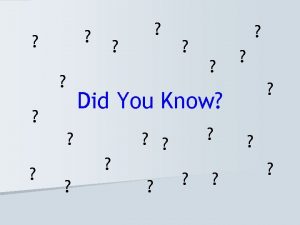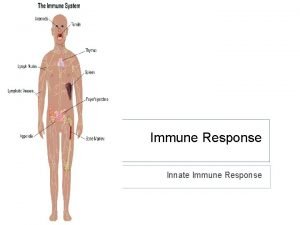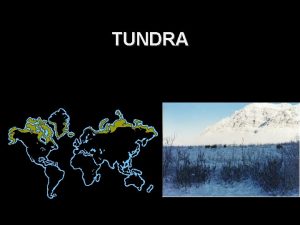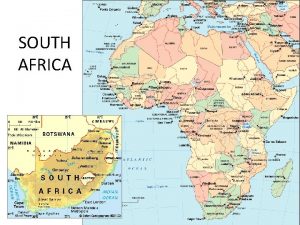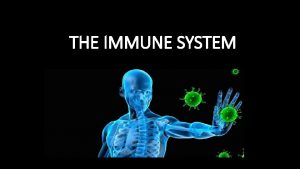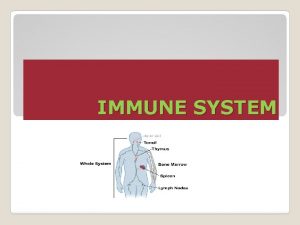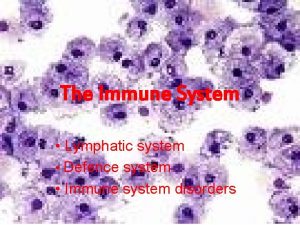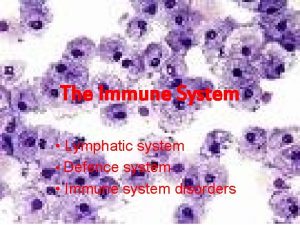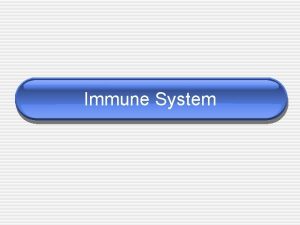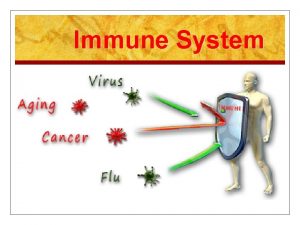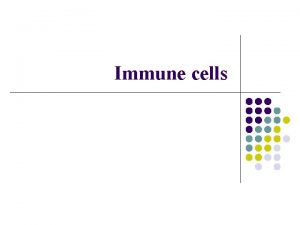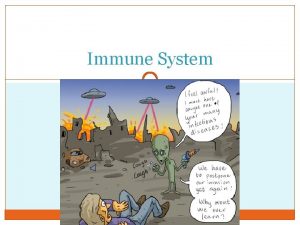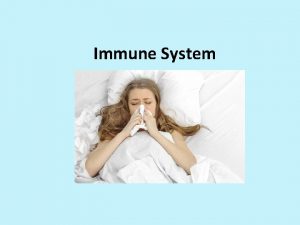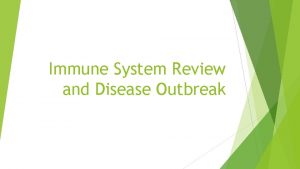Lymphatics and the Immune System Did you Know























- Slides: 23

Lymphatics and the Immune System

Did you Know § Laughing lowers levels of stress hormones and strengthens the immune system. Six-year-olds laugh an average of 300 times a day. Adults only laugh 15 to 100 times a day. 2

Lymphatic System § One way system: to the heart § Return of collected excess tissue fluid § Return of leaked protein § “Lymph” is this fluid § Edema results if system blocked or surgically removed 3

4

§ Lymph capillaries § Have one way minivalves allowing excess fluid to enter but not leave § Picks up bacteria and viruses as well as proteins, electrolytes and fluid (lymph nodes destroy most pathogens) 5

6

§ Lymph nodes: bean shaped organs along lymphatic collecting vessels § Up to 1 inch in size § Clusters of both deep and superficial LNs 7

Lymph Nodes Superficial groups -Cervical -Axillary -Inguinal Deep groups -Tracheobronchial -Aortic -Iliac Drainage -Superior R 1/4 of body: R lymphatic duct (green) * -The rest: thoracic duct * * * 8

The Immune System § Recognizes specific foreign molecules § Each exposure (to the same pathogen) increases the effectivity of the response § Lymphoid organs § § § Lymph nodes Spleen Thymus Tonsils Small intestine & appendix aggregated lymphoid nodules 9

Basic Immunology § Depends on the ability of the immune system to distinguish between self and non-self molecules § Self molecules are those components of an organism's body that can be distinguished from foreign substances by the immune system § Autoimmunity is an immune reaction against self molecules (causes various diseases) § Non-self molecules are those recognized as foreign molecules § One class of non-self molecules are called antigens (short for antibody generators) and are defined as substances that bind to specific immune receptors and elicit an immune response 10

Lymphocytes the primary cells of the lymphoid system § Respond to: § Invading organisms § Abnormal body cells, such as virus-infected cells or cancer cells § Foreign proteins such as the toxins released by some bacteria § Types of lymphocytes § T cells (thymus-dependent) § B cells (bone marrow-derived) § NK cells (natural killer) 11

NK Cells § 5 -10% of circulating lymphocytes § Attack foreign cells, normal cels infected with viruses, cancer cells that appear in normal tissues § Known as “immunologic surveillance” 12

Lymphoid Organs § § § Lymph nodes Spleen Thymus Tonsils Small intestine & appendix aggregated lymphoid nodules 13

Lymphoid Tissue Specialized connective tissue with vast quantities of lymphocytes § Lymphocytes become activated § Memory § Macrophages & dentritic cells also § Clusters of lymphoid nodules or follicles 14

Thymus § Prominent in newborns, almost disappears by old age 15

Spleen § Largest lymphoid tissue; is in LUQ posterior to stomach § Functions § § Removal of blood-borne antigens Removal & destruction of aged or defective blood cells: Stores platelets In fetus: site of hematopoiesis § Susceptible to injury; splenectomy increases risk of bacterial infection 16

Tonsils Simplest lymphoid tissue: swellings of mucosa, form a circle * * Palatine (usual tonsillitis) Lingual (tongue) * Pharyngeal (“adenoids”) Tubal 17

18

Parts of the intestine are so densely packed with MALT (mucosa-associated lymphoid tissue) that they are considered lymphoid organs § Aggregated lymphoid nodules (“Peyer’s Patches”) § About 40 follicles, 1 cm wide § Distal small intestine (ileum) § Appendix 19

Peyer’s Patches 20

21

How does HIV cause AIDS? • HIV: a retrovirus – What does this mean? – Extremely high mutation rate • Infects helper T cells, neutrophils, macrophages • Incubation: several months to years – Final stages: AIDS • No immune response capability

World AIDS Day……. December 1 st 23
 A subsequent
A subsequent Dorsal arch veins
Dorsal arch veins Venous supply of upper limb
Venous supply of upper limb Efferent lymphatics
Efferent lymphatics Chapter 35 immune system and disease
Chapter 35 immune system and disease 1st 2nd and 3rd line of defense immune system
1st 2nd and 3rd line of defense immune system Lesson 12 blood and immune system
Lesson 12 blood and immune system Lesson 12 blood and immune system
Lesson 12 blood and immune system Waldeyer's ring
Waldeyer's ring Where you went
Where you went Teapots history
Teapots history Will mandy have lunch with sue
Will mandy have lunch with sue You know minecraft
You know minecraft Did you know
Did you know What did you do on your weekend
What did you do on your weekend Friend add suffix
Friend add suffix Shoplifting facts
Shoplifting facts Suffixes for false
Suffixes for false What is the third line of defense in the immune system
What is the third line of defense in the immune system Immune system flow chart
Immune system flow chart Third line of defense immune system
Third line of defense immune system Second line of defense immune system
Second line of defense immune system Ap biology immune system
Ap biology immune system Oobean
Oobean

